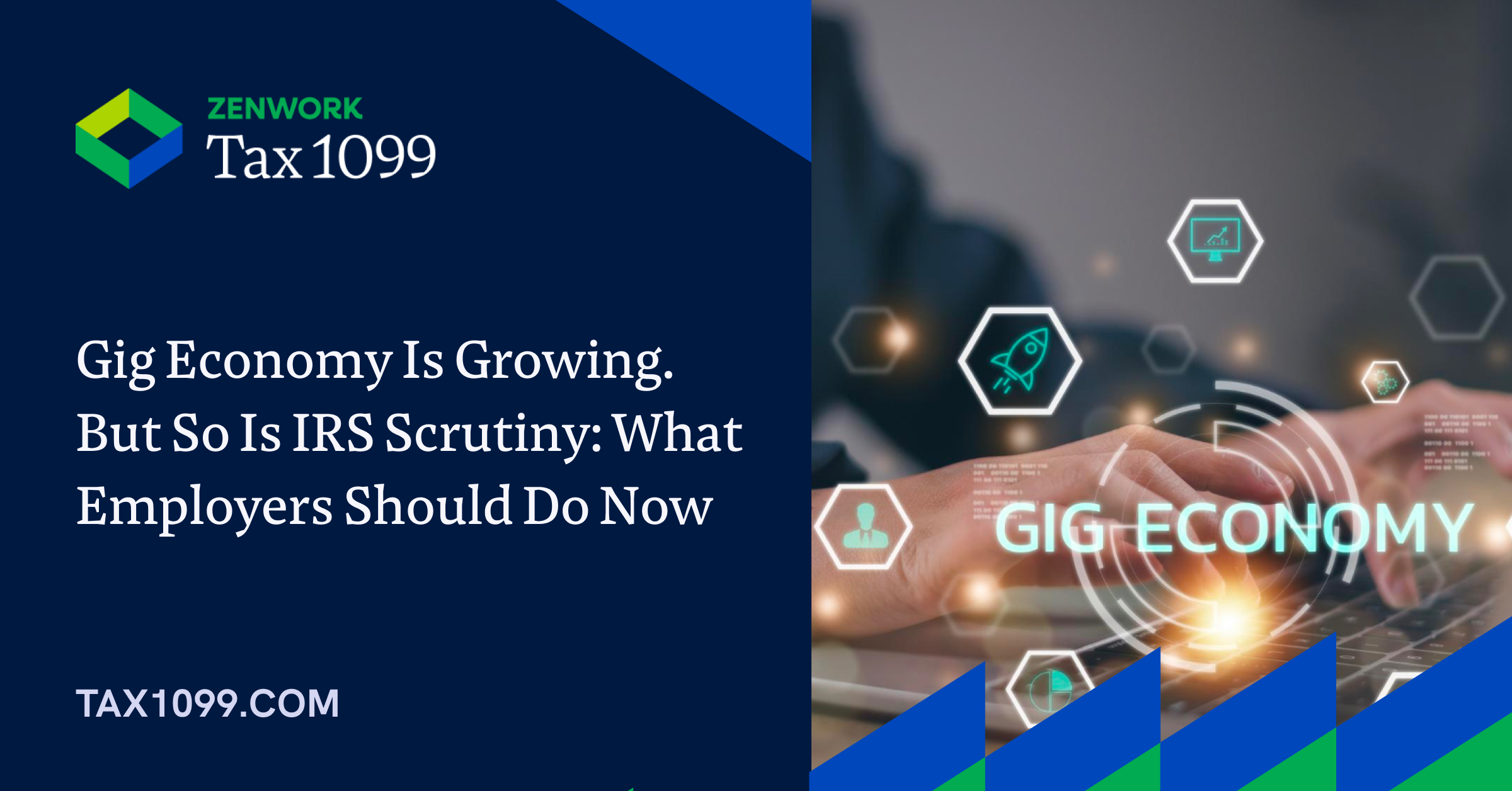The gig economy in the U.S. is growing exponentially. In just a few short years, it has seen major growth that is yet to slow down despite the economic downturns. According to recent data, the number of gig workers in the U.S. has risen to about 36.6 million, an increase from 15.8 million in 2020.
Today, nearly one-third of the U.S. workforce is engaged in some form of gig work. And this number is projected to rise to half by 2025. And it’s not just headcount- gig workers have contributed $1.27 trillion to the U.S. economy, as per a study by Upwork.
The gig economy shows no signs of slowing down. With this growth comes a growing need for tax awareness and proactive compliance among employers. But before we get into it, let’s talk about what a gig economy is.
What Is Gig Economy?
The gig economy refers to an economy that relies on short-term, flexible, and freelance jobs rather than full-time permanent employees. Workers in a gig economy are usually classified as independent contractors or gig workers. They are hired for their services and are responsible for managing their income, benefits, and taxes.
Some examples of gig work include ridesharing driver work with platforms like Uber and Lyft, food delivery (e.g., DoorDash, UberEats), and online freelancing (e.g., Fiverr, Upwork).
Why Businesses Are Shifting to Gig Work
The shift from traditional 9-to-5 employment to a gig economy is not only shaping workplace trends but also reshaping tax compliance and long-term business strategy.
The COVID pandemic and lockdown saw a major shift in work trends. With lockdown restricting the movement of people, companies started looking at hiring a new demographic of workers- the gig workers. These workers were hired based on projects or demand and helped cut costs compared to hiring a long-term employee. There is no requirement to pay payroll taxes or offer health insurance, retirement plans, paid leave, or other employee benefits. Hiring gig workers also allows companies to scale up or down based on project needs without the need to hire a full-time workforce.
1099s on the Rise: What the Numbers Tell Us
The recent shift from traditional jobs to more flexible, non-traditional work arrangements is reflected in the number of 1099 forms being filed. These forms are used to report non-employment and gig worker or freelancer income to the Internal Revenue Service (IRS).
Between 2000 and 2016, the share of workers receiving income through 1099 forms increased by 1.9%. And over half of this growth occurred from 2013 to 2016.
A study by Mercatus showed a significant increase in the total number of 1099-MISC forms issued by the IRS in the last 15 years, around a 22% increase since 2000. However, W-2 forms are stagnated in the same period, falling by around 3.5%.
With the number of gig workers increasing year after year, the IRS has taken notice. They are focused on ensuring proper classification of gig workers and accurate tax compliance.
Employers need to be aware that misclassifying an employee as an independent contractor can result in severe financial penalties, legal challenges, and damage to a company’s reputation. With the gig economy showing no signs of slowing down, employers and businesses must ensure that they steer clear of IRS scrutiny.
The Hidden Costs of Misclassifying Workers
Normally, employers are responsible for withholding income taxes and paying Social Security, Medicare, and unemployment taxes for their employees. But if a person is labeled an independent contractor instead of an employee, the employer doesn’t make these tax payments or withhold anything from the worker’s paycheck. This misclassification means the worker may not get credit for Social Security and Medicare taxes. If the IRS finds that a business misclassified a worker, it can require the business to pay back those employment taxes. Under IRC Section 3509, employers can also face penalties, fines, and interest on unpaid taxes.
Companies in the past have paid tens of millions as fines and penalties for misclassifying workers. Below, we list several high-profile employee misclassification lawsuits involving well-known companies within the last five years:
- Nike: An ongoing lawsuit from 2023 alleges that Nike misclassified thousands of workers worldwide. The company faces potential fines and class-action lawsuits that could amount to more than US$530 million in damages.
- Uber: In 2022, Uber paid US$8.4 million to settle a class-action lawsuit with California drivers who alleged Uber misclassified them as contractors
- UK Research and Innovation (UKRI): In 2021, the British non-departmental funding body UKRI paid £36 million in back taxes to British authorities for misclassifying its contractors’ IR35 status.
- FedEx: A 2021 employee misclassification lawsuit in New Jersey forced FedEx to pay US$2.4 million to 192 drivers. This is the latest in a series of misclassification lawsuits FedEx has faced over the past two decades in the U.S. that have resulted in damages ranging from US$5.3 million to US$228 million.
Understanding worker classification
The IRS classifies workers as independent contractors and employees to make tax compliance easier. It is critical for employers to correctly determine whether the person who is providing services is an employee or an independent contractor.
If a business has the right to control how and what work is done, the worker is likely an employee. Independent contractors, on the other hand, are people who run their own business or trade. They offer their services to multiple clients and have more control over how they work.
The IRS uses three main factors to evaluate the relationship between a business and a worker:
- Behavioral Control: The company controls how the worker does their job (e.g., schedule, tools, instructions).
- Financial Control: The company manages business aspects like how the worker is paid, if expenses are reimbursed, etc.
- Relationship Type: There are written contracts, the worker gets benefits (like health insurance or paid vacation), and the work is ongoing and vital to the business.
Related article: Determine Worker Classification
Still confused about whether your worker is an Independent Contractor or an Employee?
Quickly identify your worker classification according to the IRS guidelines with our easy questionnaire, and don’t let costly lawsuits haunt your business.
Impact on Tax Obligations
Worker classification determines tax obligations for both the worker and the employer. Businesses must withhold and remit income taxes, as well as Social Security and Medicare taxes under FICA, for employees. Independent contractors or gig workers can manage their tax liabilities through quarterly estimated payments and self-employment tax.
Companies must also consider implications for benefits and compensation structures. Employees are usually eligible for benefits like retirement plans, paid leave, and healthcare. Gig workers, on the other hand, are generally not given the same type of benefits. If a misclassified worker files a complaint, the employer or business may be held liable for unpaid benefits or compensation that the worker would have received as an employee.
Form 1099 Compliance for Gig Economy
In order to ensure 1099 compliance and adherence to IRS regulations, employers must adhere to these crucial steps.
1. Collect W-9 forms during onboarding
At the time of onboarding, collect information with the help of Form W-9 (Request for Taxpayer Identification Number (TIN) and Certification). This form is used to collect taxpayers’ information, including name, TIN, and business name (if applicable).
2. Verify the gig worker information
Once the worker’s information is collected, it must be verified. The IRS requires TINs, USPS addresses, and business statuses listed on the W-9 form to be verified against official records. Failure to do so can lead to compliance issues and trigger a B-notice from the IRS.
3. File federal and state 1099s
At the federal level, 1099 forms have to be filed by businesses for gig workers who have received payments worth over $600 for their services. Many states also require 1099 filings, especially those that are part of the Combined Federal/State Filing (CF/SF) Program, which allows for one consolidated filing to cover both.
4. Share recipient copies via mail or eDelivery
Employers have to send each gig worker a Copy B of their 1099 forms by January 31. This allows the gig worker to report their income accurately when they file their own tax return. The forms can be delivered to gig workers by mailing a physical copy to the provided address in the W-9 form. It can also be sent electronically via email, but only if written consent was provided by the worker.
5. Keep records for future audits
The IRS can audit tax filings up to three years after the filing date or even longer in cases of fraud. So, it’s essential to keep detailed records of W-9, payment history, TIN numbers, 1099 filing confirmations, and any other tax-related communication.
Major 1099 forms
Here are some of the key 1099 forms employers should be familiar with in the gig economy:
- 1099-NEC: Reports payments above $600 made to non-employee parties, such as vendors, freelancers, independent contractors, and more.
- 1099-MISC: Reports miscellaneous payments made in the course of a tax year.
- 1099-K: Reports payments and transactions made through third-party networks, internet platforms, and payment card processors.
- 1099-DIV: Reports dividends and distributions received from any type of investment made during the course of a tax year.
- 1099-INT: Reports interest income of at least $10.
What can employers do to mitigate IRS scrutiny?
As the IRS increases scrutiny on the gig economy, it’s more important than ever for employers and businesses to take strategic, proactive steps to avoid any liabilities.
Review Worker Classifications
Worker classification isn’t a one-and-done situation. Employers must conduct reviews of their worker classification routinely using the IRS three-factor test – behavioral control, financial control, and relationship of the parties.
Every time a worker classification is done, the reasoning should be documented. This kind of detailed recordkeeping shows the IRS that an employer acted in good faith and can be crucial during audits.
Voluntary Classification Settlement Program (VCSP)
If a business realizes it’s been misclassifying workers, it can apply for the Voluntary Classification Settlement Program (VCSP). This IRS program lets employers reclassify workers as employees going forward and offers reduced penalties.
To qualify, employers must meet specific IRS eligibility criteria, apply using Form 8952 (Application for Voluntary Classification Settlement Program), and enter into a formal agreement with the IRS.
Standardize Onboarding Processes
Employers should implement clear and consistent onboarding procedures for all gig workers. Using contracts that clearly define the scope of work, deliverables, payment terms, and the nature of the relationship helps protect both parties involved legally.
On top of that, using a standardized onboarding process also helps avoid confusion and ensures everything is properly recorded.
Educate Gig Workers
Even though it doesn’t fall under an employer’s or business’s purview, providing resources and training to gig workers about their tax responsibilities can help protect the business from potential IRS inquiries that might stem from miscommunication. It also improves trust and professional relationships between the two parties involved.
Stay Updated on Regulatory Changes
The legal and regulatory landscape surrounding the gig economy is always evolving. Staying informed about new legislation, IRS guidance, or court decisions could impact worker classification and tax obligations.
The IRS’s most recent update was lowering the threshold for Form 1099-K. This form reports transactions made via payment cards and third-party networks like PayPal, Venmo, Stripe, etc. Using a phased-in approach, the threshold went from $20,000 to $5,000 for the 2024 tax year. The threshold will go lower every tax year, and by 2026, it will be $600.
How Tax1099 Supports the Gig Economy with Accurate 1099 Filing
Tax1099 is tax software designed to simplify tax compliance for businesses that work with gig workers.
We are here to streamline tax filing and ensure compliance with features like:
- Advanced-Data Checks: Catch errors before filing with built-in validation for accurate forms.
- Bulk TIN Matching: Verify TIN/Name combos in bulk to avoid costly IRS mismatches and penalties.
- Single Sign-On & Workflow Management: Manage all client data and users in one place with access controls.
- Easy Data Imports: Import contractor info from Excel, QuickBooks, Sage, and more.
- AI Tax Assistance: Get 24/7 help from our AI chat assistant when filing questions.
- IRS-Compliant eDelivery: Deliver 1099s electronically to recipients and reduce mailing costs.
- API Integration: Seamlessly integrate Tax1099 with your system to automate filings.



